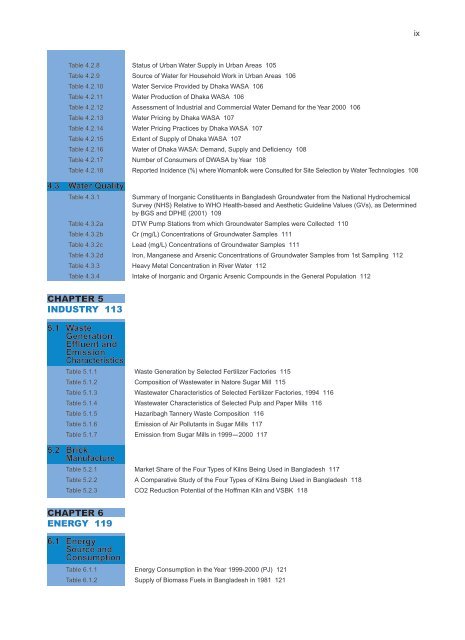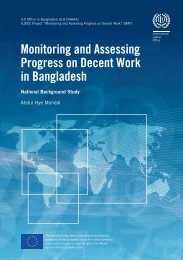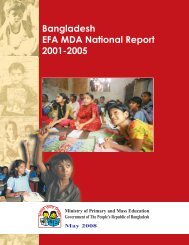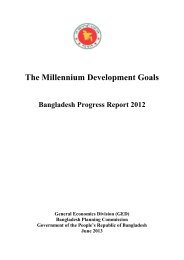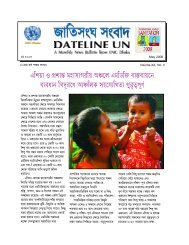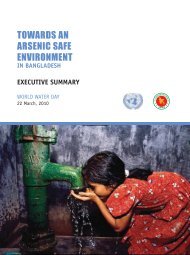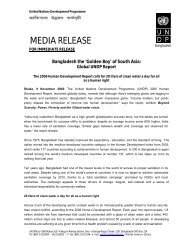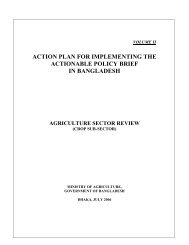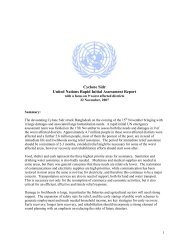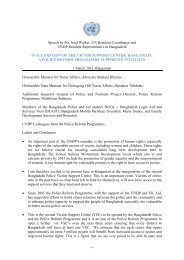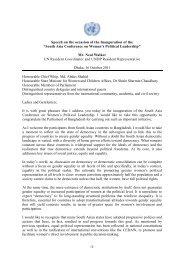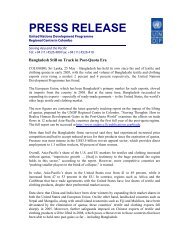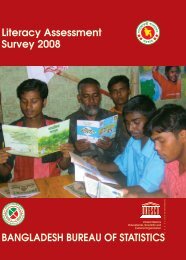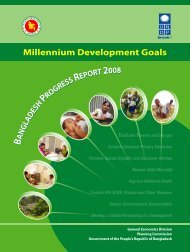Database - United Nations in Bangladesh
Database - United Nations in Bangladesh
Database - United Nations in Bangladesh
Create successful ePaper yourself
Turn your PDF publications into a flip-book with our unique Google optimized e-Paper software.
ix<br />
Table 4.2.8 Status of Urban Water Supply <strong>in</strong> Urban Areas 105<br />
Table 4.2.9 Source of Water for Household Work <strong>in</strong> Urban Areas 106<br />
Table 4.2.10 Water Service Provided by Dhaka WASA 106<br />
Table 4.2.11 Water Production of Dhaka WASA 106<br />
Table 4.2.12 Assessment of Industrial and Commercial Water Demand for the Year 2000 106<br />
Table 4.2.13 Water Pric<strong>in</strong>g by Dhaka WASA 107<br />
Table 4.2.14 Water Pric<strong>in</strong>g Practices by Dhaka WASA 107<br />
Table 4.2.15 Extent of Supply of Dhaka WASA 107<br />
Table 4.2.16 Water of Dhaka WASA: Demand, Supply and Deficiency 108<br />
Table 4.2.17 Number of Consumers of DWASA by Year 108<br />
Table 4.2.18 Reported Incidence (%) where Womanfolk were Consulted for Site Selection by Water Technologies 108<br />
4.3 Water Quality<br />
Table 4.3.1<br />
Summary of Inorganic Constituents <strong>in</strong> <strong>Bangladesh</strong> Groundwater from the National Hydrochemical<br />
Survey (NHS) Relative to WHO Health-based and Aesthetic Guidel<strong>in</strong>e Values (GVs), as Determ<strong>in</strong>ed<br />
by BGS and DPHE (2001) 109<br />
Table 4.3.2a DTW Pump Stations from which Groundwater Samples were Collected 110<br />
Table 4.3.2b Cr (mg/L) Concentrations of Groundwater Samples 111<br />
Table 4.3.2c Lead (mg/L) Concentrations of Groundwater Samples 111<br />
Table 4.3.2d Iron, Manganese and Arsenic Concentrations of Groundwater Samples from 1st Sampl<strong>in</strong>g 112<br />
Table 4.3.3 Heavy Metal Concentration <strong>in</strong> River Water 112<br />
Table 4.3.4 Intake of Inorganic and Organic Arsenic Compounds <strong>in</strong> the General Population 112<br />
CHAPTER 5<br />
INDUSTRY 113<br />
5.1 Waste<br />
Generation,<br />
Effluent and<br />
Emission<br />
Characteristics<br />
Table 5.1.1 Waste Generation by Selected Fertilizer Factories 115<br />
Table 5.1.2 Composition of Wastewater <strong>in</strong> Natore Sugar Mill 115<br />
Table 5.1.3 Wastewater Characteristics of Selected Fertilizer Factories, 1994 116<br />
Table 5.1.4 Wastewater Characteristics of Selected Pulp and Paper Mills 116<br />
Table 5.1.5 Hazaribagh Tannery Waste Composition 116<br />
Table 5.1.6 Emission of Air Pollutants <strong>in</strong> Sugar Mills 117<br />
Table 5.1.7 Emission from Sugar Mills <strong>in</strong> 1999-2000 117<br />
5.2 Brick<br />
Manufacture<br />
Table 5.2.1 Market Share of the Four Types of Kilns Be<strong>in</strong>g Used <strong>in</strong> <strong>Bangladesh</strong> 117<br />
Table 5.2.2 A Comparative Study of the Four Types of Kilns Be<strong>in</strong>g Used <strong>in</strong> <strong>Bangladesh</strong> 118<br />
Table 5.2.3 CO2 Reduction Potential of the Hoffman Kiln and VSBK 118<br />
CHAPTER 6<br />
ENERGY 119<br />
6.1 Energy<br />
Source and<br />
Consumption<br />
Table 6.1.1 Energy Consumption <strong>in</strong> the Year 1999-2000 (PJ) 121<br />
Table 6.1.2 Supply of Biomass Fuels <strong>in</strong> <strong>Bangladesh</strong> <strong>in</strong> 1981 121


